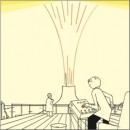 In The New Yorker, Elizabeth Kolbert plays skeptic to a controversial bestseller (how could one be skeptical about anything with a dignified name like “superfreakonomics”?):
In The New Yorker, Elizabeth Kolbert plays skeptic to a controversial bestseller (how could one be skeptical about anything with a dignified name like “superfreakonomics”?):
[W]hat’s most troubling about SuperFreakonomics isn’t the authors’ many blunders; it’s the whole spirit of the enterprise. Though climate change is a grave problem, Levitt and Dubner treat it mainly as an opportunity to show how clever they are. Leaving aside the question of whether geoengineering, as it is known in scientific circles, is even possible—have you ever tried sending an eighteen-mile-long hose into the stratosphere?—their analysis is terrifyingly cavalier. A world whose atmosphere is loaded with carbon dioxide, on the one hand, and sulfur dioxide, on the other, would be a fundamentally different place from the earth as we know it.
She also throws into the bargain a swipe at scientist Freeman Dyson:
“Carbon-eating trees” certainly sound nice. But how, exactly, would they work? Dyson has never elaborated, and neither the Times nor The Atlantic seems to have asked. Would the trees take up CO2 while they’re alive, and release it back into the atmosphere only slowly, once they’re dead? If so, the world already has those sorts of trees. They are called, well, trees. Or would the trees absorb carbon dioxide from the air and convert it, as Dyson once vaguely suggested, into “liquid fuels,” so that instead of at gas stations we could fill up our cars at orchards? In that case, the idea seems not so much “brave” as off the wall. (Dyson, it should be noted, has also proposed genetically engineering plants made of silicon and trees that could be grown on Mars.)
(Illustration by Laurent Cilluffo for The New Yorker)

